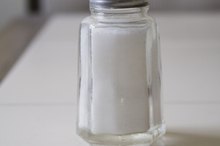What does fact checked mean?
At Healthfully, we strive to deliver objective content that is accurate and up-to-date. Our team periodically reviews articles in order to ensure content quality. The sources cited below consist of evidence from peer-reviewed journals, prominent medical organizations, academic associations, and government data.
- American Heart Association: Sodium (Salt or Sodium Chloride)
- American Heart Association: Cutting Down on Salt and Sodium for People with Heart Failure
The information contained on this site is for informational purposes only, and should not be used as a substitute for the advice of a professional health care provider. Please check with the appropriate physician regarding health questions and concerns. Although we strive to deliver accurate and up-to-date information, no guarantee to that effect is made.
The Sodium Content of Canned Tuna
Sodium is an important mineral that serves a variety of functions in the body. However, consuming too much sodium can raise blood pressure levels and increase the risk of heart-related problems. Canned tuna is a good source of several important nutrients that promote health, but is it important to be aware of the different canning methods to limit excess sodium in the diet.
Sodium Content
Canned tuna is available in regular and light versions and is canned in water or oil and with or without salt. All tuna canned without salt in water or oil contains 42.5 mg of sodium per 3 ounces, according to Calorie Lab 2. Light tuna canned in oil with salt contains 300 mg of sodium and light tuna canned in water with salt contains 287 mg of sodium per 3 ounces. Regular white tuna canned in oil with salt contains the highest amount of sodium with 336 mg per 3 ounces and regular white tuna canned in water with salt contains 320 mg of sodium.
- Canned tuna is available in regular and light versions and is canned in water or oil and with or without salt.
- Regular white tuna canned in oil with salt contains the highest amount of sodium with 336 mg per 3 ounces and regular white tuna canned in water with salt contains 320 mg of sodium.
Dietary Reference Intakes
Canned Tuna & Potassium
Learn More
The majority of Americans consume too much sodium per day with the average American consuming approximately 3,400 mg of sodium per day, according to the American Heart Association 14. The Institue of Medicine recommends consuming at least 1,500 mg of sodium per day with maximum daily amounts not to exceed 2,300 mg. The American Heart Association recommends individual’s with heart failure to limit sodium intake to less than 2,000 mg per day 14. A low-sodium diet can help reduce blood pressure and lower the risk of cardiovascular disease. The amount of sodium in foods is always listed on the nutrition facts labels along with the percent daily value. It is important to look at serving sizes to determine the entire amount of sodium in the package.
- The majority of Americans consume too much sodium per day with the average American consuming approximately 3,400 mg of sodium per day, according to the American Heart Association 1.
- It is important to look at serving sizes to determine the entire amount of sodium in the package.
Sodium and Health
Sodium is an important mineral because it helps maintain the balance of fluids in the body and is needed for the conduction of nerve impulses and muscle contraction. However, consuming too much sodium is a major factor in the development of high blood pressure, as excess sodium causes the body to retain water and makes the heart work harder. Sodium is naturally present in a variety of foods, but the majority of an individual’s sodium intake comes from the sodium added to processed and prepared foods. In addition, adding table salt to foods greatly increases daily sodium intake as just a single teaspoon of salt contains approximately 2,300 mg of sodium. It is important to avoid high-sodium foods and prepare low or no-sodium foods, particularly for individuals with heart disease.
- Sodium is an important mineral because it helps maintain the balance of fluids in the body and is needed for the conduction of nerve impulses and muscle contraction.
- However, consuming too much sodium is a major factor in the development of high blood pressure, as excess sodium causes the body to retain water and makes the heart work harder.
Considerations
A Low-Salt, Low-Fat & Low-Cholesterol Diet
Learn More
When consuming canned tuna, it is best to select light tuna in water without the added salt to greatly reduce the sodium content as well as lower calorie, fat and saturated fat amounts 2. Tuna is a very good source of protein and omega-3 fatty acids as well as B-vitamins and the mineral selenium. Also, if mixing the tuna with mayonnaise, it is best to choose low-sodium mayonnaise to minimize excess sodium intake.
Related Articles
References
- American Heart Association: Sodium (Salt or Sodium Chloride)
- American Heart Association: Cutting Down on Salt and Sodium for People with Heart Failure
- American Heart Association. Sources of Sodium.
- Centers for Disease Control and Prevention. Top 10 Sources of Sodium. 2017.
- Institute of Medicine. Dietary Reference Intakes Tables and Application. National Academies of Sciences, Engineering, and Medicine, Health and Medicine Division. 2015.
- United States Department of Agriculture. Dietary Guidelines for Americans 2015–2020. United States Department of Health and Human Services. 2015.
Writer Bio
Jason Dority has been writing health-related articles and developing community resources for healthier lifestyles since 2007. He currently works for the Indiana University School of Medicine's Diabetes Translational Research Center. Dority holds a Master of Science in biology from Indiana University.









